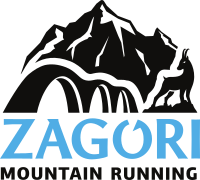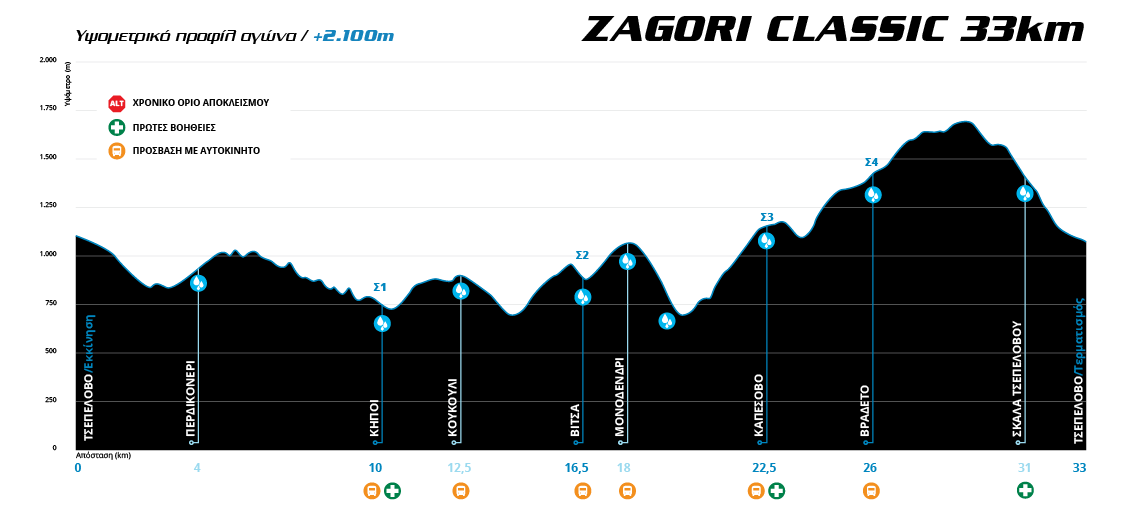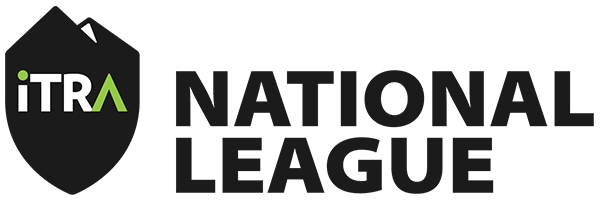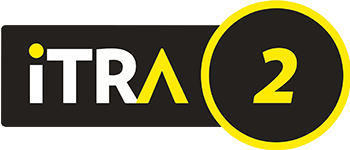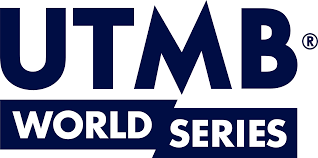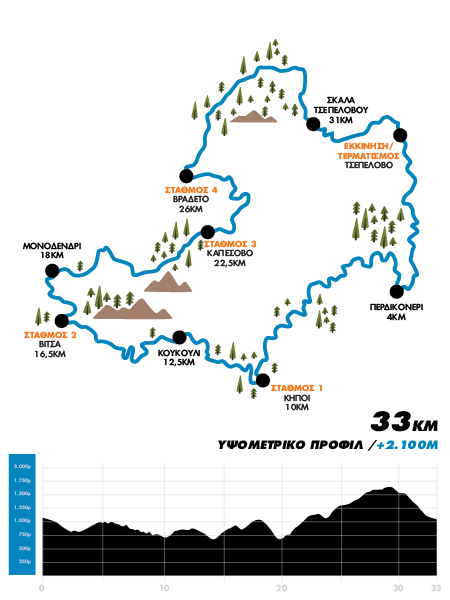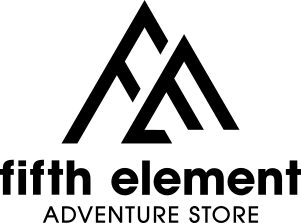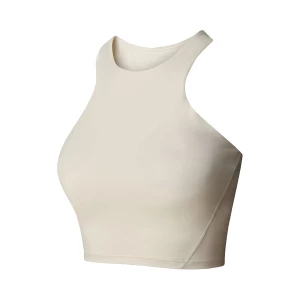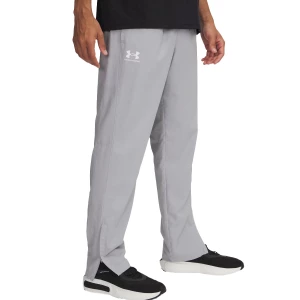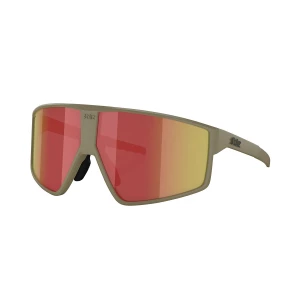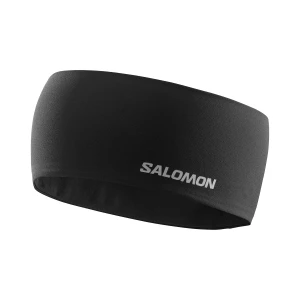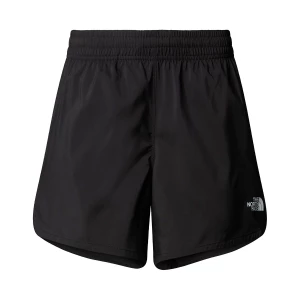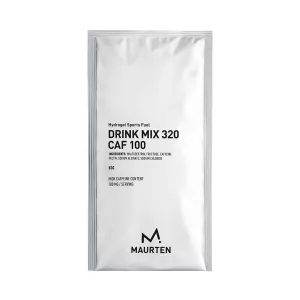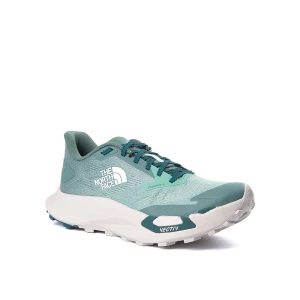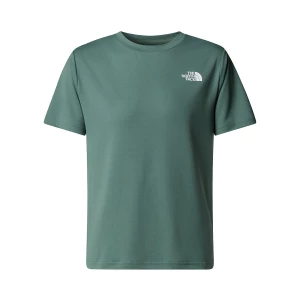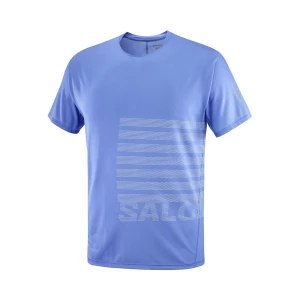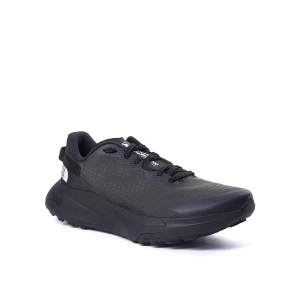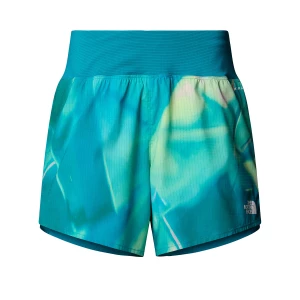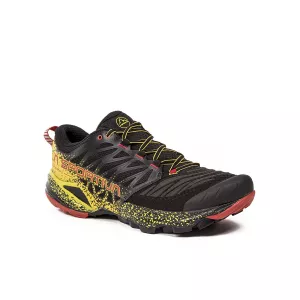Zagori Classic Race 33km
Discover the largest part of Zagori’s cultural heritage through a 33km race.
- 20/07/2025
- 06:30
A few words about the Zagori Classic Race 33km
A new race on an enjoyable yet highly demanding 33km circular route, with 2,100 m of positive elevation gain, challenges you to raise your personal goals and experience mountain running from a different perspective. This unique course passes through many villages, stone steps, and bridges of Zagori!
Virtual 3d map
Race description
The Zagori Classic Race 33km route passes through 7 villages of Zagori and is as follows:
Tsepelovo – Kipoi – Koukouli – Vitsa – Monodendri – Kapesovo – Vradeto – Tsepelovo
Athletes pass through 6 “stone steps” (skales): Bagia/Kontodimos, Koukouli, Vitsa, Monodendri, Vradeto, and Tsepelovo, as well as the following stone bridges: Hatsios, Kovatseinas, Kontodimos, Misios, the “Pera” bridge and the “Dothe” bridge.
The route starts at the Tsepelovo High School and runs clockwise. The first 2.6 km are downhill on a dirt road. Continuing on, runners cross the Hatsios Bridge, with the entrance to the Vikos Gorge visible on the right.
They then climb for the next 1.4 km, pass “Perdikoni” and reach the 4th km (water station), then enter the magical new trail that leads to Kipoi after 6 km (10th km), where the Main Aid Station is located.
From there, the route continues to the Kontodimos Bridge and climbs up the Bagia/Kontodimos steps to the village of Koukouli (12.5 km). It then descends via the Koukouli steps to the stone Misios Bridge. Next, runners climb the Vitsa steps, which lead directly into the village and to the Vitsa Main Aid Station.
Leaving Vitsa behind, they continue along a trail for 1.5 km to reach the village of Monodendri at the 18th km, having gained a total of +1,000 m of elevation so far. After a stop at the aid station, they head to the first major descent of the race, the Monodendri steps. After a short run inside the gorge, crossing it, they begin the race’s longest climb along the “Mohican Trail” to the village of Kapesovo (22.5 km – elevation gain 1,470 m). After reaching the village, they run a short stretch on asphalt and then descend on a dirt road to the Vradeto steps.
There begins the final long climb up to the village of Vradeto, and at the 26th km they continue for another 3 km on an uphill trail, reaching the race’s highest point (1,620 m), with a total ascent of 2,080 m positive elevation gain. Then begins the final long 4 km descent, which leads to the finish line via the Tsepelovo steps.
Athlete Aid Stations for the Zagori Classic Race 33km Race
Running, and especially long-distance running — whether in terms of time or distance — is inherently linked to energy intake. The importance of proper nutrition during a race, for those who have experience in long-distance events, is considered the ‘key’ to achieving a desirable outcome. This does not only relate to performance, but also to the enjoyment the race provides and the avoidance of the so-called ‘survival mode’.
The main philosophy of the team responsible for the race nutrition is to offer participants a variety of flavors that can meet even the most specific needs. The selection and placement of different nutritional options at the aid stations have been designed to enable athletes to meet their energy requirements. Special emphasis has been placed on helping less experienced runners, who can participate even without a personal nutrition plan. The aid station setup is designed to prevent energy depletion that may arise due to lack of similar racing experience.
The recommended selection and placement of supplies at the aid stations have been made with a view to covering the energy needs according to international guidelines and relevant scientific literature.
Every trail running race is unique, and so is every athlete. The individual differences among athletes are significant, and striving to meet their energy needs is our motivation. A complementary and decisive factor in shaping our race nutrition approach is our own personal experience as athletes, the creation of similar nutrition protocols for our runners, and your feedback, which has guided our planning.
- *C.E.G.: Cumulative Elevation Gain
- *Bar: Carbohydrates & protein bars
- *Salty foods: Biscuits, crisps, peanuts, bread and turkey slice
- *Soft Drinks: Cola
- *Fruits: Watermelon or banana etc.
Refreshment Stations are all manned stations with at least 2 volunteers who will help and provide supplies to the athletes.
| km | Σ.Θ.Υ.Δ. | Τοποθεσία | Φυσικό μεταλλικό νερό ΖΑΓΟΡΙ | Ισοτονικό Ρόφημα Gold Nutrition | Τζελ Nomad Honey | Μπάρα Neversecond | Κέικ | Αποξηραμένα φρούτα | Αλμυρά | Cola | Μπανάνα Dole | Sandwich Τυρί |
|---|---|---|---|---|---|---|---|---|---|---|---|---|
| 4 | +100m | ΠΕΡΔΙΚΟΝΕΡΙ | ||||||||||
| 10 | +290m | ΚΗΠΟΙ | ||||||||||
| 12.5 | +150m | ΚΟΥΚΟΥΛΙ | ||||||||||
| 16 | +200m | ΒΙΤΣΑ | ||||||||||
| 18 | +200m | ΜΟΝΟΔΕΝΔΡΙ | ||||||||||
| 22.5 | +400m | ΚΑΠΕΣΟΒΟ | ||||||||||
| 26 | +440m | ΒΡΑΔΕΤΟ | ||||||||||
| 31 | +300m | ΣΚΑΛΑ ΤΣΕΠΕΛΟΒΟΥ |
The races route in GPX file format
You can download the Zagori Classic Race 33km route in GPX format and upload it to your watch.
The file is compressed (in zip format) so you have to unzip it first in order to import it.
MANDATORY & RECOMMENDED EQUIPMENT
Mandatory Equipment – Zagori Classic Race 33km
Athletes must carry a bottle (with a capacity of at least 500 ml) and/or a cup for drinks at the aid stations (water, soft drinks, etc.).
The organizers do not provide cups at the aid stations. Each athlete is responsible for selecting the container (cup, flask, bladder, bottle, etc.) they will use to receive the offered liquids. Drinks will be served using practical dispensers by the aid station staff. For faster service, athletes should have containers with a wide opening for quick refilling. Athletes are responsible for carrying one or two containers to hold water and isotonic drink separately.
Carrying a hydration pack, backpack, or waist pack is allowed. Leaving packs along the course at central aid stations is at the athlete’s own risk.
Each athlete has the right to carry any equipment they consider necessary to cope with the race’s challenges. The organizers reserve the right to conduct random checks for equipment compliance both at the start and during the race.
The organizers recommend a minimum kit, referred to as the “Survival Equipment”, which is deemed absolutely necessary for an athlete running for so many consecutive hours.
The suggested Survival Equipment includes:
- Mobile phone
- Mini first aid kit
- Waterproof jacket (depending on weather conditions)
- Solid food
- Emergency thermal blanket
In addition to the above, each athlete may add vital medications they may need, as well as other practical items, such as:
- Gaiters
- Cup for liquids
- Trekking poles
- Sun hat
- Electrolyte supplement, etc.
Recommended Equipment
The organizers recommend that athletes carry a small backpack or waist pack with some basic supplies, such as:
- Sunglasses
- Hat
- Bladder or bottle with a wide opening
- Solid food of their choice to meet their needs between aid stations.
In the event of an accident or serious issue that triggers an alert to the designated rescue teams, the organizers will also check the athlete’s mandatory equipment. If it is determined that the athlete endangered themselves due to their own negligence (because of insufficient equipment), the penalty will be disqualification from the race and exclusion from participating in the event the following year.
Examples of serious negligence include:
- Hypothermia due to lack of appropriate clothing
- Dehydration due to not carrying a hydration container
